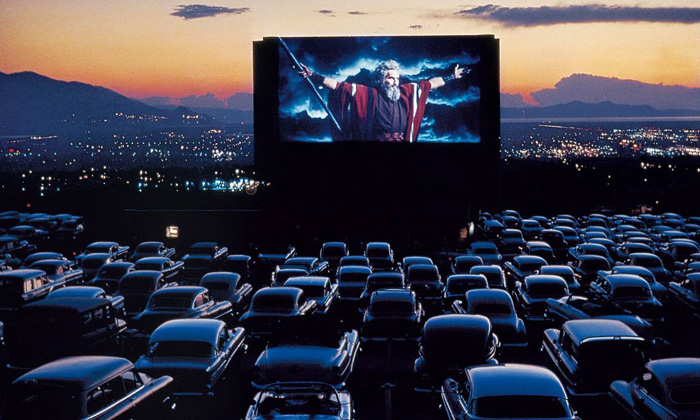
Gary Kushner is returning from the snack bar skillfully carrying four sodas and a large bucket of popcorn for himself, his wife and his two children. His family is in their car eagerly waiting for the last trace of the summer sun to disappear behind the horizon. The Kushners have made their yearly pilgrimage to the Transit Drive-in Theatre, a 60-plus-year-old drive-in that sits about 30 miles from Buffalo, New York.
Though Kushner moved away from the area a number of years ago, he makes a point to return the drive-in every summer with his family, so they can have the outdoor movie-going experience that he did as a kid. “I grew up not that far from here, and we used to come here all of the time,” says Kushner. “It was important to me that they had a chance to experience this too. Sitting at home and watching Netflix, or even going to a regular movie theater pales in comparison to this. There’s just something magical about it.”

Drive-in movie theaters have become a part of the American cultural lexicon. The mid-twentieth century found a multitude of drive-ins blanketing the country. Rick Cohen, the owner of the Transit Drive-in, cites the freedom of being outside as part of their allure. “You’re able to enjoy the outdoors and look up at the stars,” says Cohen. “That’s what I really get out of it. It’s an outdoor experience in combination with being able to watch a movie.”
The first official drive-in movie theater was opened in 1933 by Richard Hollingshead in Camden, New Jersey. He had first conceived of the idea when he was trying to accommodate his mother, who was too large for indoor movie theater seats. He had the idea to put a projector on the hood of his car and tie sheets between trees in his yard. Hollingshead’s drive-in included a patented ramp system allowing the cars to park at different heights for better viewing. The first film screened at his drive-in was the British comedy “Wives Beware.”
A few more drive-ins opened around the country in the following years, but they did not gain in popularity until the advent of in-car speakers in the early 1940s. By the mid-1950s, there were between 4,000 and 5,000 drive-ins in the U.S., becoming a popular and affordable destination for families and teens. Concessions stands were a large part of their financial success. The cafeteria-style operation allowed owners to serve hundreds of customers during the 10-minute intermission.
In the coming decades, the popularity of drive-ins would begin to wane. Multiplexes capable of showing multiple daily viewings of a film gave customers more flexibility. The oil crisis in the 1970s resulted in less recreational driving, and the advent of home video gave a more convenient option for enjoying movies. To try to make up for lost revenue, drive-ins began showing low-budget B movies and adult content.

As a result of suburban expansion, the land on which the drive-ins sat became more valuable than the profits being made. Developers made offers to the owners that drive-in owners couldn’t turn down. “They were steamed rolled by progress,” says Cohen. “When they were built in the 1950s, it was all just empty farmland.” As the towns and the communities grew, many drive-ins were no longer practical in their location. More and more drive-ins began to close, and at present, there are less than 400 left in the U.S.
There has been a bit of a resurgence in interest in drive-ins in recent years. Many are offering weekday-night double features with classic films from the 1980s and 1990s, though it isn’t necessarily profitable for the owners. “It hasn’t been a huge income generator because the licensing fees can be pretty stiff, but people enjoy it and it does help a little bit,” says Cohen. The Transit Drive-in also offers miniature golf, but like the classic films, it brings in little money. “Most of the money that comes in from the miniature golf goes back into it for maintenance and operating cost,” says Cohen. “We put it in to give people more of an experience and to give people a reason to come early to alleviate traffic before the movies.”
Threatening the surge in popularity of drive-ins is the film industry’s move away from 35-millimeter film projection and toward digital projection, which has proven to be difficult for many drive-in theater owners. Cohen has been able to make the transition, but with price tags for digital projectors ranging between $60,000 and $80,000, it can be cost prohibitive for many owners. Cohen has made efforts to assist his fellow owners in the transition. “I helped raise funds for digital conversions, and I’ve provided free consultation to several drive-ins to help them make the transition from 35-millimeter,” says Cohen.
While the increase in interest has led to a small number of new drive-ins being built, they have yet to see the popularity they once saw. Despite that, Cohen stays optimistic about the industry. “The popularity of indoor movie theater business continues to be strong,” says Cohen. “But if there are good movies and good weather, drive-in theaters will continue to do well. The best thing drive-ins can do to make themselves more competitive in today’s entertainment landscape is to focus on presentation quality, customer service and adding more screens to offer more diverse choices.”

